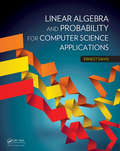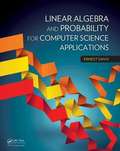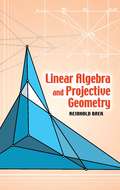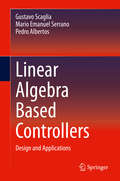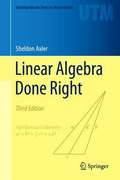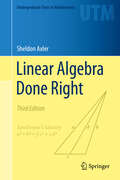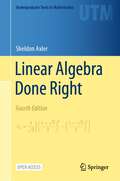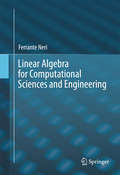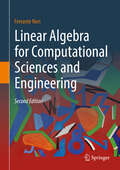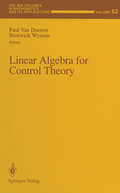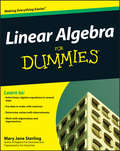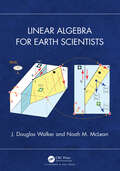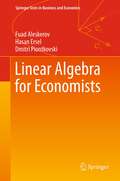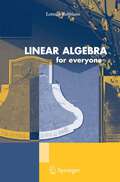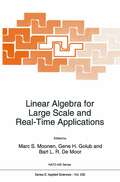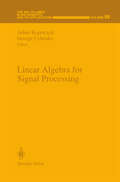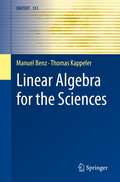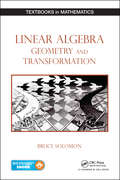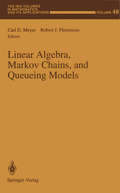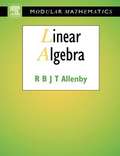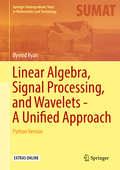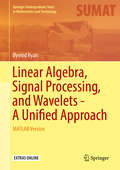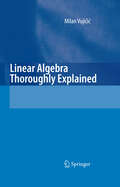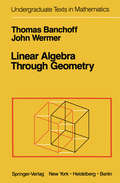- Table View
- List View
Linear Algebra and Probability for Computer Science Applications
by Ernest DavisBased on the author's course at NYU, Linear Algebra and Probability for Computer Science Applications gives an introduction to two mathematical fields that are fundamental in many areas of computer science. The course and the text are addressed to students with a very weak mathematical background. Most of the chapters discuss relevant MATLAB functi
Linear Algebra and Probability for Computer Science Applications (PDF)
by Ernest DavisBased on the author's course at NYU, Linear Algebra and Probability for Computer Science Applicationsgives an introduction to two mathematical fields that are fundamental in many areas of computer science. The course and the text are addressed to students with a very weak mathematical background. Most of the chapters discuss relevant MATLAB#65533;functions and features and give sample assignments in MATLAB; the author's website provides the MATLAB code from the book. After an introductory chapter on MATLAB, the text is divided into two sections. The section on linear algebra gives an introduction to the theory of vectors, matrices, and linear transformations over the reals. It includes an extensive discussion on Gaussian elimination, geometric applications, and change of basis. It also introduces the issues of numerical stability and round-off error, the discrete Fourier transform, and singular value decomposition. The section on probability presents an introduction to the basic theory of probability and numerical random variables; later chapters discuss Markov models, Monte Carlo methods, information theory, and basic statistical techniques. The focus throughout is on topics and examples that are particularly relevant to computer science applications; for example, there is an extensive discussion on the use of hidden Markov models for tagging text and a discussion of the Zipf (inverse power law) distribution. Examples and Programming Assignments The examples and programming assignments focus on computer science applications. The applications covered are drawn from a range of computer science areas, including computer graphics, computer vision, robotics, natural language processing, web search, machine learning, statistical analysis, game playing, graph theory, scientific computing, decision theory, coding, cryptography, network analysis, data compression, and signal processing. Homework ProblemsComprehensive problem sections include traditional calculation exercises, thought problems such as proofs, and programming assignments that involve creating MATLAB functions.
Linear Algebra and Projective Geometry
by Reinhold BaerGeared toward upper-level undergraduates and graduate students, this text establishes that projective geometry and linear algebra are essentially identical. The supporting evidence consists of theorems offering an algebraic demonstration of certain geometric concepts. These focus on the representation of projective geometries by linear manifolds, of projectivities by semilinear transformations, of collineations by linear transformations, and of dualities by semilinear forms. These theorems lead to a reconstruction of the geometry that constituted the discussion's starting point, within algebraic structures such as the endomorphism ring of the underlying manifold or the full linear group.Restricted to topics of an algebraic nature, the text shows how far purely algebraic methods may extend. It assumes only a familiarity with the basic concepts and terms of algebra. The methods of transfinite set theory frequently recur, and for readers unfamiliar with this theory, the concepts and principles appear in a special appendix.
Linear Algebra Based Controllers: Design and Applications
by Gustavo Scaglia Mario Emanuel Serrano Pedro AlbertosThis book summarizes the application of linear algebra-based controllers (LABC) for trajectory tracking for practitioners and students across a range of engineering disciplines. It clarifies the necessary steps to apply this straight-forward technique to a non-linear multivariable system, dealing with continuous or discrete time models, and outlines the steps to implement such controllers. In this book, the authors present an approach of the trajectory tracking problem in systems with dead time and in the presence of additive uncertainties and environmental disturbances. Examples of applications of LABC to systems in real operating conditions (mobile robots, marine vessels, quadrotor and pvtol aircraft, chemical reactors and First Order Plus Dead Time systems) illustrate the controller design in such a way that the reader attains an understanding of LABC.
Linear Algebra Done Right (Undergraduate Texts In Mathematics Ser. (PDF))
by Sheldon AxlerThis best-selling textbook for a second course in linear algebra is aimed at undergrad math majors and graduate students. The novel approach taken here banishes determinants to the end of the book. The text focuses on the central goal of linear algebra: understanding the structure of linear operators on finite-dimensional vector spaces. The author has taken unusual care to motivate concepts and to simplify proofs. A variety of interesting exercises in each chapter helps students understand and manipulate the objects of linear algebra. The third edition contains major improvements and revisions throughout the book. More than 300 new exercises have been added since the previous edition. Many new examples have been added to illustrate the key ideas of linear algebra. New topics covered in the book include product spaces, quotient spaces, and dual spaces. Beautiful new formatting creates pages with an unusually pleasant appearance in both print and electronic versions. No prerequisites are assumed other than the usual demand for suitable mathematical maturity. Thus the text starts by discussing vector spaces, linear independence, span, basis, and dimension. The book then deals with linear maps, eigenvalues, and eigenvectors. Inner-product spaces are introduced, leading to the finite-dimensional spectral theorem and its consequences. Generalized eigenvectors are then used to provide insight into the structure of a linear operator.
Linear Algebra Done Right (Undergraduate Texts in Mathematics)
by Sheldon AxlerThis best-selling textbook for a second course in linear algebra is aimed at undergrad math majors and graduate students. The novel approach taken here banishes determinants to the end of the book. The text focuses on the central goal of linear algebra: understanding the structure of linear operators on finite-dimensional vector spaces. The author has taken unusual care to motivate concepts and to simplify proofs. A variety of interesting exercises in each chapter helps students understand and manipulate the objects of linear algebra.The third edition contains major improvements and revisions throughout the book. More than 300 new exercises have been added since the previous edition. Many new examples have been added to illustrate the key ideas of linear algebra. New topics covered in the book include product spaces, quotient spaces, and dual spaces. Beautiful new formatting creates pages with an unusually pleasant appearance in both print and electronic versions.No prerequisites are assumed other than the usual demand for suitable mathematical maturity. Thus the text starts by discussing vector spaces, linear independence, span, basis, and dimension. The book then deals with linear maps, eigenvalues, and eigenvectors. Inner-product spaces are introduced, leading to the finite-dimensional spectral theorem and its consequences. Generalized eigenvectors are then used to provide insight into the structure of a linear operator.
Linear Algebra Done Right (Undergraduate Texts in Mathematics)
by Sheldon AxlerNow available in Open Access, this best-selling textbook for a second course in linear algebra is aimed at undergraduate math majors and graduate students. The fourth edition gives an expanded treatment of the singular value decomposition and its consequences. It includes a new chapter on multilinear algebra, treating bilinear forms, quadratic forms, tensor products, and an approach to determinants via alternating multilinear forms. This new edition also increases the use of the minimal polynomial to provide cleaner proofs of multiple results. Also, over 250 new exercises have been added.The novel approach taken here banishes determinants to the end of the book. The text focuses on the central goal of linear algebra: understanding the structure of linear operators on finite-dimensional vector spaces. The author has taken unusual care to motivate concepts and simplify proofs. A variety of interesting exercises in each chapter helps students understand and manipulate the objects of linear algebra. Beautiful formatting creates pages with an unusually student-friendly appearance in both print and electronic versions. No prerequisites are assumed other than the usual demand for suitable mathematical maturity. The text starts by discussing vector spaces, linear independence, span, basis, and dimension. The book then deals with linear maps, eigenvalues, and eigenvectors. Inner-product spaces are introduced, leading to the finite-dimensional spectral theorem and its consequences. Generalized eigenvectors are then used to provide insight into the structure of a linear operator.From the reviews of previous editions:Altogether, the text is a didactic masterpiece. — zbMATHThe determinant-free proofs are elegant and intuitive. — American Mathematical MonthlyThe most original linear algebra book to appear in years, it certainly belongs in every undergraduate library — CHOICE
Linear Algebra for Computational Sciences and Engineering
by Ferrante NeriThis book presents the main concepts of linear algebra from the viewpoint of applied scientists such as computer scientists and engineers, without compromising on mathematical rigor. Based on the idea that computational scientists and engineers need, in both research and professional life, an understanding of theoretical concepts of mathematics in order to be able to propose research advances and innovative solutions, every concept is thoroughly introduced and is accompanied by its informal interpretation. Furthermore, most of the theorems included are first rigorously proved and then shown in practice by a numerical example. When appropriate, topics are presented also by means of pseudocodes, thus highlighting the computer implementation of algebraic theory.It is structured to be accessible to everybody, from students of pure mathematics who are approaching algebra for the first time to researchers and graduate students in applied sciences who need a theoretical manual of algebra to successfully perform their research. Most importantly, this book is designed to be ideal for both theoretical and practical minds and to offer to both alternative and complementary perspectives to study and understand linear algebra.
Linear Algebra for Computational Sciences and Engineering
by Ferrante NeriThis book presents the main concepts of linear algebra from the viewpoint of applied scientists such as computer scientists and engineers, without compromising on mathematical rigor. Based on the idea that computational scientists and engineers need, in both research and professional life, an understanding of theoretical concepts of mathematics in order to be able to propose research advances and innovative solutions, every concept is thoroughly introduced and is accompanied by its informal interpretation. Furthermore, most of the theorems included are first rigorously proved and then shown in practice by a numerical example. When appropriate, topics are presented also by means of pseudocodes, thus highlighting the computer implementation of algebraic theory.It is structured to be accessible to everybody, from students of pure mathematics who are approaching algebra for the first time to researchers and graduate students in applied sciences who need a theoretical manual of algebra to successfully perform their research. Most importantly, this book is designed to be ideal for both theoretical and practical minds and to offer to both alternative and complementary perspectives to study and understand linear algebra.
Linear Algebra for Control Theory (The IMA Volumes in Mathematics and its Applications #62)
by Paul Van Dooren Bostwick WymanDuring the past decade the interaction between control theory and linear algebra has been ever increasing, giving rise to new results in both areas. As a natural outflow of this research, this book presents information on this interdisciplinary area. The cross-fertilization between control and linear algebra can be found in subfields such as Numerical Linear Algebra, Canonical Forms, Ring-theoretic Methods, Matrix Theory, and Robust Control. This book's editors were challenged to present the latest results in these areas and to find points of common interest. This volume reflects very nicely the interaction: the range of topics seems very wide indeed, but the basic problems and techniques are always closely connected. And the common denominator in all of this is, of course, linear algebra.This book is suitable for both mathematicians and students.
Linear Algebra For Dummies
by Mary Jane SterlingLearn to: Solve linear algebra equations in several ways Put data in order with matrices Determine values with determinants Work with eigenvalues and eigenvectors Your hands-on guide to real-world applications of linear algebra Does linear algebra leave you feeling lost? No worries —this easy-to-follow guide explains the how and the why of solving linear algebra problems in plain English. From matrices to vector spaces to linear transformations, you'll understand the key concepts and see how they relate to everything from genetics to nutrition to spotted owl extinction. Line up the basics — discover several different approaches to organizing numbers and equations, and solve systems of equations algebraically or with matrices Relate vectors and linear transformations — link vectors and matrices with linear combinations and seek solutions of homogeneous systems Evaluate determinants — see how to perform the determinant function on different sizes of matrices and take advantage of Cramer's rule Hone your skills with vector spaces — determine the properties of vector spaces and their subspaces and see linear transformation in action Tackle eigenvalues and eigenvectors — define and solve for eigenvalues and eigenvectors and understand how they interact with specific matrices Open the book and find: Theoretical and practical ways of solving linear algebra problems Definitions of terms throughout and in the glossary New ways of looking at operations How linear algebra ties together vectors, matrices, determinants, and linear transformations Ten common mathematical representations of Greek letters Real-world applications of matrices and determinants
Linear Algebra for Earth Scientists
by J. Douglas Walker Noah M. McLeanLinear Algebra for Earth Scientists is written for undergraduate and graduate students in Earth and Environmental sciences. It is intended to give students enough background in linear algebra to work with systems of equations and data in geology, hydrology, geophysics, or whatever part of the Earth Sciences they engage with.The book does not presuppose any extensive prior knowledge of linear algebra. Instead, the book builds students up from a low base to a working understanding of the sub t that they can apply to their work, using many familiar examples in the geosciences.Features Suitable for students of Earth and Environmental Sciences Minimal prerequisites — written in a way that is accessible and engaging for those without a mathematical background All material presented with examples and applications to the Earth Sciences
Linear Algebra for Earth Scientists
by J. Douglas Walker Noah M. McLeanLinear Algebra for Earth Scientists is written for undergraduate and graduate students in Earth and Environmental sciences. It is intended to give students enough background in linear algebra to work with systems of equations and data in geology, hydrology, geophysics, or whatever part of the Earth Sciences they engage with.The book does not presuppose any extensive prior knowledge of linear algebra. Instead, the book builds students up from a low base to a working understanding of the sub t that they can apply to their work, using many familiar examples in the geosciences.Features Suitable for students of Earth and Environmental Sciences Minimal prerequisites — written in a way that is accessible and engaging for those without a mathematical background All material presented with examples and applications to the Earth Sciences
Linear Algebra for Economists (Springer Texts in Business and Economics)
by Fuad Aleskerov Hasan Ersel Dmitri PiontkovskiThis textbook introduces students of economics to the fundamental notions and instruments in linear algebra. Linearity is used as a first approximation to many problems that are studied in different branches of science, including economics and other social sciences. Linear algebra is also the most suitable to teach students what proofs are and how to prove a statement. The proofs that are given in the text are relatively easy to understand and also endow the student with different ways of thinking in making proofs. Theorems for which no proofs are given in the book are illustrated via figures and examples. All notions are illustrated appealing to geometric intuition. The book provides a variety of economic examples using linear algebraic tools. It mainly addresses students in economics who need to build up skills in understanding mathematical reasoning. Students in mathematics and informatics may also be interested in learning about the use of mathematics in economics.
Linear Algebra for Everyone
by Lorenzo RobbianoThis book provides students with the rudiments of Linear Algebra, a fundamental subject for students in all areas of science and technology. The book would also be good for statistics students studying linear algebra.It is the translation of a successful textbook currently being used in Italy. The author is a mathematician sensitive to the needs of a general audience. In addition to introducing fundamental ideas in Linear Algebra through a wide variety of interesting examples, the book also discusses topics not usually covered in an elementary text (e.g. the "cost" of operations, generalized inverses, approximate solutions). The challenge is to show why the "everyone" in the title can find Linear Algebra useful and easy to learn.The translation has been prepared by a native English speaking mathematician, Professor Anthony V. Geramita.
Linear Algebra for Large Scale and Real-Time Applications (NATO Science Series E: #232)
by M. S. Moonen Gene H. Golub B. L. De MoorProceedings of the NATO Advanced Study Institute, Leuven, Belgium, August 3-14, 1992
Linear Algebra for Signal Processing (The IMA Volumes in Mathematics and its Applications #69)
by Adam Bojanczyk George CybenkoSignal processing applications have burgeoned in the past decade. During the same time, signal processing techniques have matured rapidly and now include tools from many areas of mathematics, computer science, physics, and engineering. This trend will continue as many new signal processing applications are opening up in consumer products and communications systems. In particular, signal processing has been making increasingly sophisticated use of linear algebra on both theoretical and algorithmic fronts. This volume gives particular emphasis to exposing broader contexts of the signal processing problems so that the impact of algorithms and hardware can be better understood; it brings together the writings of signal processing engineers, computer engineers, and applied linear algebraists in an exchange of problems, theories, and techniques. This volume will be of interest to both applied mathematicians and engineers.
Linear Algebra for the Sciences (UNITEXT #151)
by Manuel Benz Thomas KappelerThis book is based on a course for first-semester science students, held by the second author at the University of Zurich several times. Its goal is threefold: to have students learn a minimal working knowledge of linear algebra, acquire some computational skills, and familiarize them with mathematical language to make mathematical literature more accessible. Therefore, we give precise definitions, introduce helpful notations, and state any results carefully worded. We provide no proofs of these results but typically illustrate them with numerous examples. Additionally, for better understanding, we often give supporting arguments for why they are valid.
Linear Algebra, Geometry and Transformation (Textbooks In Mathematics Ser.)
by Bruce SolomonThe Essentials of a First Linear Algebra Course and MoreLinear Algebra, Geometry and Transformation provides students with a solid geometric grasp of linear transformations. It stresses the linear case of the inverse function and rank theorems and gives a careful geometric treatment of the spectral theorem.An Engaging Treatment of the Interplay amo
Linear Algebra, Markov Chains, and Queueing Models (The IMA Volumes in Mathematics and its Applications #48)
by Carl D. Meyer Robert J. PlemmonsThis IMA Volume in Mathematics and its Applications LINEAR ALGEBRA, MARKOV CHAINS, AND QUEUEING MODELS is based on the proceedings of a workshop which was an integral part of the 1991-92 IMA program on "Applied Linear Algebra". We thank Carl Meyer and R.J. Plemmons for editing the proceedings. We also take this opportunity to thank the National Science Founda tion, whose financial support made the workshop possible. A vner Friedman Willard Miller, Jr. xi PREFACE This volume contains some of the lectures given at the workshop Lin ear Algebra, Markov Chains, and Queueing Models held January 13-17, 1992, as part of the Year of Applied Linear Algebra at the Institute for Mathematics and its Applications. Markov chains and queueing models play an increasingly important role in the understanding of complex systems such as computer, communi cation, and transportation systems. Linear algebra is an indispensable tool in such research, and this volume collects a selection of important papers in this area. The articles contained herein are representative of the underlying purpose of the workshop, which was to bring together practitioners and re searchers from the areas of linear algebra, numerical analysis, and queueing theory who share a common interest of analyzing and solving finite state Markov chains. The papers in this volume are grouped into three major categories-perturbation theory and error analysis, iterative methods, and applications regarding queueing models.
Linear Algebra (PDF)
by Reg AllenbyAs the basis of equations (and therefore problem-solving), linear algebra is the most widely taught sub-division of pure mathematics. Dr Allenby has used his experience of teaching linear algebra to write a lively book on the subject that includes historical information about the founders of the subject as well as giving a basic introduction to the mathematics undergraduate. The whole text has been written in a connected way with ideas introduced as they occur naturally. As with the other books in the series, there are many worked examples.
Linear Algebra, Signal Processing, and Wavelets - A Unified Approach: Python Version (Springer Undergraduate Texts in Mathematics and Technology)
by Øyvind RyanThis book offers a user friendly, hands-on, and systematic introduction to applied and computational harmonic analysis: to Fourier analysis, signal processing and wavelets; and to their interplay and applications. The approach is novel, and the book can be used in undergraduate courses, for example, following a first course in linear algebra, but is also suitable for use in graduate level courses. The book will benefit anyone with a basic background in linear algebra. It defines fundamental concepts in signal processing and wavelet theory, assuming only a familiarity with elementary linear algebra. No background in signal processing is needed. Additionally, the book demonstrates in detail why linear algebra is often the best way to go. Those with only a signal processing background are also introduced to the world of linear algebra, although a full course is recommended.The book comes in two versions: one based on MATLAB, and one on Python, demonstrating the feasibility and applications of both approaches. Most of the code is available interactively. The applications mainly involve sound and images. The book also includes a rich set of exercises, many of which are of a computational nature.
Linear Algebra, Signal Processing, and Wavelets - A Unified Approach: MATLAB Version (Springer Undergraduate Texts in Mathematics and Technology)
by Øyvind RyanThis book offers a user friendly, hands-on, and systematic introduction to applied and computational harmonic analysis: to Fourier analysis, signal processing and wavelets; and to their interplay and applications. The approach is novel, and the book can be used in undergraduate courses, for example, following a first course in linear algebra, but is also suitable for use in graduate level courses. The book will benefit anyone with a basic background in linear algebra. It defines fundamental concepts in signal processing and wavelet theory, assuming only a familiarity with elementary linear algebra. No background in signal processing is needed. Additionally, the book demonstrates in detail why linear algebra is often the best way to go. Those with only a signal processing background are also introduced to the world of linear algebra, although a full course is recommended. The book comes in two versions: one based on MATLAB, and one on Python, demonstrating the feasibility and applications of both approaches. Most of the MATLAB code is available interactively. The applications mainly involve sound and images. The book also includes a rich set of exercises, many of which are of a computational nature.
Linear Algebra Thoroughly Explained
by Milan VujicicThe author of this book was Professor of Theoretical Physics at the University of Belgrade. The book is based on lectures he gave there to both undergraduate and postgraduate students over a period of several decades. It sets out to explain Linear Algebra from its fundamentals to the most advanced level. A special feature of this book is its didactical approach, with a myriad of thoroughly worked examples and excellent illustrations, which allows the reader to approach the subject from any level and to proceed to that of the most advanced applications. Throughout, the subject is explained with painstaking care.
Linear Algebra Through Geometry (Undergraduate Texts in Mathematics)
by T. Banchoff J. WermerIn this book we lead the student to an understanding of elementary linear algebra by emphasizing the geometric significance of the subject. Our experience in teaching beginning undergraduates over the years has convinced us that students learn the new ideas of linear algebra best when these ideas are grounded in the familiar geometry of two and three dimensions. Many important notions of linear algebra already occur in these dimensions in a non-trivial way, and a student with a confident grasp of these ideas will encounter little difficulty in extending them to higher dimensions and to more abstract algebraic systems. Moreover, we feel that this geometric approach provides a solid basis for the linear algebra needed in engineering, physics, biology, and chemistry, as well as in economics and statistics. The great advantage of beginning with a thorough study of the linear algebra of the plane is that students are introduced quickly to the most important new concepts while they are still on the familiar ground of two-dimensional geometry. In short order, the student sees and uses the notions of dot product, linear transformations, determinants, eigenvalues, and quadratic forms. This is done in Chapters 2.0-2.7. Then the very same outline is used in Chapters 3.0-3.7 to present the linear algebra of three-dimensional space, so that the former ideas are reinforced while new concepts are being introduced.
